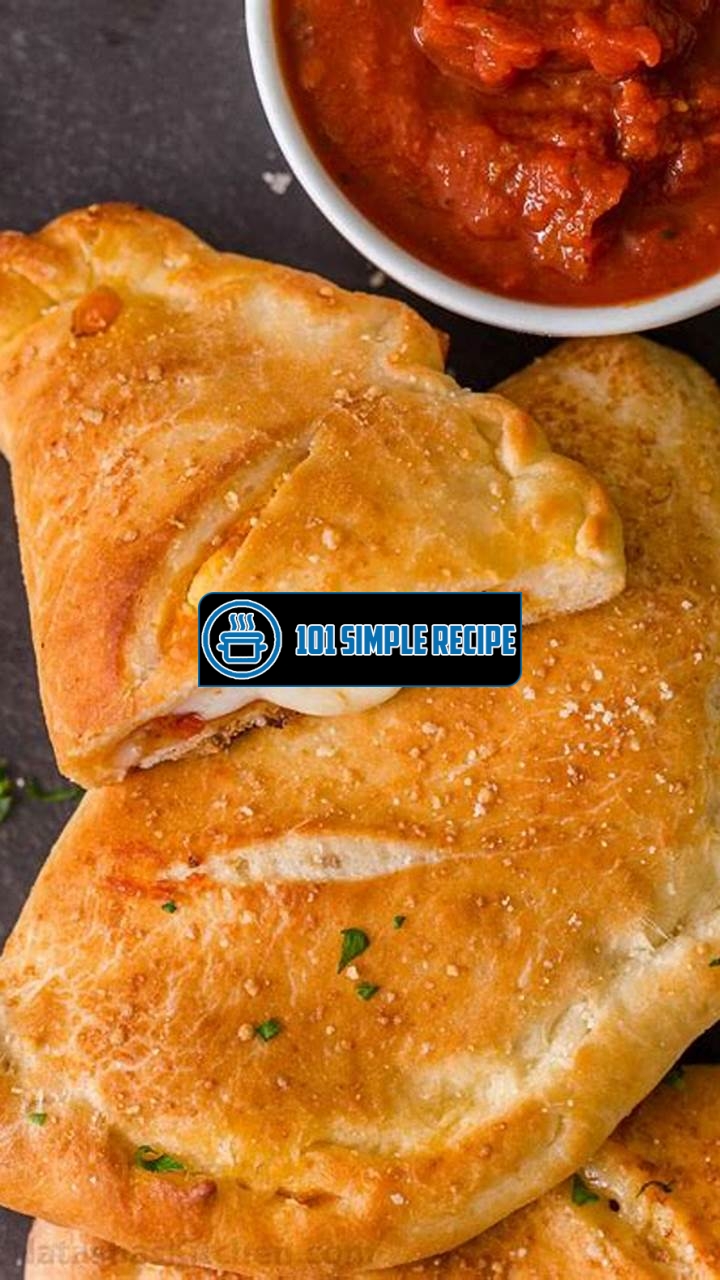Are you craving for a delectable and satisfying savory treat? Look no further because we have the perfect solution for you! Introducing our Delicious Homemade Calzone Dough Recipe for Savory Pleasure that will surely make your taste buds dance with joy. Whether you are a seasoned chef or a kitchen novice, this recipe is incredibly easy to follow and guarantees mouth-watering results. With just a few simple ingredients and a little bit of your time, you can create the most heavenly calzones filled with your favorite savory fillings. So put on your apron and get ready to embark on a culinary adventure like no other!

Why Homemade Calzone Dough is Worth the Effort
Discover the reasons why making your own calzone dough from scratch is a game-changer for your homemade pizza nights.
1. Superior Flavor: When you prepare your own homemade calzone dough, you have complete control over the ingredients and flavors. The result is a superior taste that can never be replicated by store-bought dough. By using high-quality ingredients and adding your own personal touch, you can tailor the flavor to suit your preferences, whether it’s a hint of garlic, a sprinkle of herbs, or a touch of spice. The possibilities are endless and will surely tantalize your taste buds. ️
2. Health Benefits: Homemade calzone dough is a healthier alternative to commercially made options. By using fresh, wholesome ingredients and avoiding additives or preservatives, you can ensure that you and your loved ones are consuming a nutritious and wholesome meal. Additionally, you can control the amount of salt and oil used in the dough to make it even more heart-healthy. Taking care of your health never tasted so good!
3. Therapeutic Process: Making homemade calzone dough is more than just a cooking activity; it’s a therapeutic experience. Kneading the dough with your own hands allows you to release any stress or tension while connecting with the food you’re about to create. The act of creating something from scratch can be incredibly fulfilling and provide a sense of accomplishment that ready-made dough simply can’t replicate. It’s the epitome of cooking as an art form.
4. Cost Savings: While making homemade calzone dough requires a bit of effort, it’s actually a cost-effective choice in the long run. Store-bought dough can be pricey, especially if you frequently indulge in homemade pizzas or calzones. By investing some time into making your own dough, you can save money and even customize it to suit your budget. Plus, the satisfaction of knowing you created a delicious meal from scratch is priceless.
5. Customization Galore: One of the biggest advantages of making your own calzone dough is the freedom to customize it to your heart’s content. From choosing the type of flour to adding various seasonings, you have the power to create a dough that perfectly suits your taste. You can experiment with different herbs, spices, and even fillings, turning every calzone into a unique culinary masterpiece. Let your creativity run wild in the kitchen! ️
Conclusion: Making homemade calzone dough is a labor of love that pays off in flavor, health benefits, cost savings, and the joy of creating something from scratch. Don’t settle for mediocre store-bought options when you can elevate your homemade pizza nights with a delicious and customized dough. Embrace the process, unleash your creativity, and savor the mouthwatering results. Your taste buds will thank you!
Essential Ingredients for Perfect Homemade Calzone Dough
When it comes to making a delicious homemade calzone, the secret lies in the dough. The right combination of ingredients will give you a soft, chewy, and flavorful crust that will have your taste buds dancing. Let’s explore the key components that you need to master in order to achieve dough perfection.
The Role of Flour in Calzone Dough
Flour is the foundation of any dough recipe, including calzone dough. It provides the structure and texture that you desire. The type of flour you choose will affect the final outcome of your calzone crust.
All-purpose flour: This versatile flour is commonly used in calzone dough recipes. It has a moderate amount of protein, which helps create a tender crust.
Bread flour: For a chewier and sturdier crust, you can opt for bread flour. It has a higher protein content, which results in a more elastic dough.
Whole wheat flour: If you prefer a healthier option, you can use whole wheat flour in your calzone dough. It adds a nutty flavor and extra nutrition to your crust.
Gluten-free flour: For those with gluten sensitivities, there are various gluten-free flours available that can be used as a substitute for traditional flour. These flours are typically a blend of rice flour, tapioca flour, and potato starch.
Using a combination of flours: You can experiment with different combinations of flours to achieve a unique flavor and texture in your calzone dough. Just make sure to adjust the liquid proportions accordingly.
The Importance of Water in Calzone Dough
Water plays a vital role in calzone dough as it helps activate the yeast and forms gluten, which gives the dough its elasticity. The amount of water you use will depend on the type of flour you are using and the desired consistency of your dough.
Consistency: The dough should be soft and slightly tacky to the touch. If it’s too dry, add more water a tablespoon at a time. If it’s too wet, add a little flour until you achieve the right consistency.
Temperature: The temperature of the water is also important. It should be lukewarm, around 110°F (43°C), to help activate the yeast. However, be cautious not to use water that is too hot, as it can kill the yeast.
Yeast: Yeast is typically added to the water and allowed to bloom before mixing it with the flour. This step ensures that the yeast is active and will help the dough rise.
Kneading: Once the water and yeast are combined, it’s time to knead the dough. This process helps develop the gluten and gives the dough its elasticity. Knead the dough for at least 10 minutes until it becomes smooth and elastic.
Resting: After kneading, the dough needs to rest and rise. Place it in a greased bowl, cover it with a damp towel, and let it rise in a warm place until it doubles in size. This usually takes about 1-2 hours.
Adding a Touch of Sweetness: Sugar in Calzone Dough
Sugar may not be a traditional ingredient in calzone dough, but it can add a hint of sweetness and enhance the flavors of the other ingredients. It also aids in the fermentation process and helps brown the crust during baking.
Amount: The amount of sugar to add will vary depending on personal preference. Generally, 1-2 tablespoons of granulated sugar or honey will suffice.
Dissolving: To ensure that the sugar is evenly distributed in the dough, dissolve it in the lukewarm water before adding the yeast.
Effects: Adding sugar to your calzone dough can result in a slightly sweeter and darker crust. It can also accelerate the fermentation process, reducing the rising time of the dough.
In conclusion, a perfect homemade calzone dough requires the right combination of flour, water, and a touch of sweetness. Experimenting with different flours and adjusting the liquid proportions will allow you to create a dough that suits your personal preferences. Remember to knead the dough thoroughly, let it rise, and add a dash of sugar to enhance the flavors. With these essential ingredients, you’ll be well on your way to making savory calzones that will delight your taste buds.
The Science Behind the Perfect Calzone Dough
Delve into the scientific principles that influence the texture, rise, and overall quality of homemade calzone dough.
Yeast: The Magic Ingredient for Dough Rise
When it comes to making homemade calzone dough, yeast plays a vital role in achieving that perfect rise and texture. Yeast is a single-celled organism that ferments the sugars present in the dough, producing carbon dioxide gas as a byproduct. The gas gets trapped in the dough, creating air pockets and causing the dough to rise.
The type of yeast used can significantly impact the outcome of your calzone dough. There are two common types of yeast: active dry yeast and instant yeast. Active dry yeast requires proofing, which involves dissolving the yeast in warm water before adding it to the dough. On the other hand, instant yeast can be added directly to the dry ingredients.
Pro Tip: Make sure the water used to activate the yeast is warm, but not too hot. Water that is too hot can kill the yeast and prevent proper dough rise.
Another important factor to consider is the amount of yeast used. Too little yeast will result in a dense and flat calzone dough, while too much yeast can cause the dough to rise too quickly and create an airy texture. The ideal amount of yeast varies depending on the recipe and personal preference, so it may take some experimentation to find the perfect balance.
Understanding Gluten Formation in Calzone Dough
Gluten is a protein that forms when wheat flour is combined with water. It gives the dough its elasticity and structure, allowing it to stretch and trap air during the rising process. Understanding how gluten forms is crucial in achieving the ideal texture for your calzone dough.
When water is added to the flour, two proteins present in wheat flour, glutenin and gliadin, combine to form gluten. This process is known as hydration. Kneading the dough further develops the gluten network, allowing it to become stronger and more elastic.
Pro Tip: Knead your dough until it becomes smooth and elastic. This can take anywhere from 8 to 10 minutes. Overkneading can lead to tough dough, so be sure to keep an eye on the texture.
The Art of Achieving the Ideal Dough Consistency
Consistency is key when it comes to calzone dough. The ideal consistency should be soft, slightly tacky, and easy to handle. Achieving this consistency requires a careful balance of ingredients and techniques.
Start by measuring your ingredients accurately. Too much flour can result in a dry and tough dough, while too little can make it sticky and unworkable. Using a kitchen scale can help ensure precise measurements.
Additionally, the hydration of the dough plays a significant role in its consistency. The hydration refers to the amount of water present in relation to the amount of flour. A higher hydration level creates a softer and more extensible dough, while a lower hydration level yields a firmer and less extensible dough.
Pro Tip: Adjust the hydration level as needed to achieve the desired dough consistency. If the dough feels too dry, add a small amount of water. If it feels too sticky, gradually incorporate more flour until it reaches the desired texture.
Once the dough is mixed and kneaded, it should be allowed to rise in a warm environment until it doubles in size. This process can take anywhere from 1 to 2 hours, depending on the temperature and yeast activity.
Pro Tip: To create an ideal rising environment, cover the dough with a clean kitchen towel or plastic wrap and place it in a warm spot free from drafts.
In conclusion, achieving the perfect calzone dough requires understanding the science behind it. By harnessing the power of yeast for dough rise, understanding gluten formation, and mastering the dough consistency, you can create homemade calzones with a satisfying texture and taste.
Step-by-Step Instructions for Homemade Calzone Dough
Follow a detailed guide on how to make your very own calzone dough, ensuring foolproof results every time.
Measuring and Sifting Dry Ingredients
Start by measuring and sifting the dry ingredients for your homemade calzone dough. This step is crucial in ensuring the perfect texture and taste of your calzone. When measuring the flour, make sure to use a dry measuring cup by spooning the flour into the cup and leveling it off with a straight edge. Sift the flour, salt, and sugar together into a large mixing bowl to remove any lumps and aerate the mixture.
- Tip: Use a kitchen scale for precise measurements.
- Tip: Sifting the dry ingredients helps to incorporate air and prevent clumps.
- Tip: Consider using a combination of all-purpose flour and bread flour for a chewier texture.
Proofing the Yeast and Activating it Perfectly
Next, you’ll need to proof the yeast to ensure its quality and activate it perfectly. In a small bowl, combine warm water, a pinch of sugar, and the yeast. Give it a gentle stir and let it sit for about 5-10 minutes until the mixture becomes foamy. This indicates that the yeast is alive and active.
- Important: Make sure the water is warm (around 110°F/43°C), but not too hot to avoid killing the yeast.
- Tip: Adding a pinch of sugar helps to feed the yeast and promote fermentation.
- Emoji:
Kneading and Resting the Dough for Optimal Texture
Now it’s time to knead and rest the dough for optimal texture. Transfer the proofed yeast mixture into the bowl with the sifted dry ingredients. Use a wooden spoon or your hands to combine the mixture until it forms a shaggy dough. Once it comes together, turn the dough out onto a lightly floured surface and knead it for about 8-10 minutes. The dough should be smooth, elastic, and slightly tacky.
Note: Kneading helps to develop the gluten in the dough and create a chewy texture.
After kneading, shape the dough into a ball and place it in a lightly greased bowl. Cover the bowl with a clean kitchen towel or plastic wrap and let the dough rise in a warm, draft-free area for about 1-2 hours or until it has doubled in size. This resting period allows the yeast to ferment and impart flavor into the dough.
- Important: Choose a warm spot for the dough to rise, such as near a window or on top of a preheated oven.
- Tip: You can test if the dough has risen enough by gently poking it with your finger. If the indentation remains, it’s ready.
Once the dough has risen, it’s now ready to be shaped into calzones and filled with your favorite savory ingredients. Roll it out, add your desired fillings, fold it over, and seal the edges. Bake in a preheated oven until golden brown and delight in the homemade goodness of your calzone.
Enjoy the satisfaction of making your very own homemade calzone dough and indulge in the savory pleasure it brings!
Perfecting Calzone Dough: Tips and Tricks
Unlock expert tips and tricks to elevate your calzone making skills and troubleshoot common dough-related issues.
Troubleshooting: Dealing with Tough or Sticky Dough
If you find yourself dealing with tough or sticky dough while preparing your homemade calzones, don’t worry! We have some useful tips to help you overcome this common issue.
- Measure your ingredients precisely: One of the most common reasons for tough or sticky dough is inaccurate measurement of ingredients. Make sure you use measuring cups and spoons for both dry and wet ingredients, and follow the recipe closely.
- Knead the dough properly: Kneading is an essential step in developing gluten and creating a stretchy, elastic dough. Knead the dough until it becomes smooth and supple, which usually takes around 8-10 minutes.
- Adjust flour or water: If your dough is too sticky, gradually add more flour, a tablespoon at a time, until it reaches the desired consistency. If it’s too tough, add small amounts of water or oil and knead it in to soften the dough.
- Allow proper resting and rising time: Dough needs time to rest and rise, allowing the gluten to relax and the yeast to activate. Follow the recipe instructions for resting and rising, and avoid rushing this process.
- Use the right flour: Different types of flour have different protein contents, which can affect the texture of your dough. For a lighter and less chewy calzone crust, opt for all-purpose flour instead of bread flour.
By following these troubleshooting tips, you’ll be able to handle tough or sticky dough effortlessly and create perfectly textured calzones each time.
Enhancing Flavor: Incorporating Herbs and Spices
Take your homemade calzone dough to the next level by incorporating herbs and spices into the mix. This will not only add extra flavor but also elevate the overall taste of your calzones.
- Oregano and basil: These classic Italian herbs are perfect additions to your calzone dough. Add a teaspoon or two of dried oregano and basil to the dough mixture, or sprinkle some fresh herbs over the filling before sealing your calzones.
- Garlic and onion powder: For a savory and aromatic twist, incorporate garlic and onion powder into your dough. Use half a teaspoon of each for a subtle flavor, or adjust according to your preference.
- Red pepper flakes: If you’re a fan of a little heat, sprinkle some red pepper flakes into your calzone dough. This will give your calzones a mild spicy kick without overpowering the other flavors.
- Cheese and herb blend: Experiment with a blend of different cheeses and herbs to create a unique flavor profile for your calzone dough. Mozzarella, Parmesan, and a combination of fresh herbs like thyme and rosemary work wonderfully together.
Remember, you have the freedom to tailor the herbs and spices to suit your taste preferences. Feel free to get creative and experiment with different combinations to find your perfect calzone flavor.
Freezing and Storing Homemade Calzone Dough
If you want to make your calzone dough in advance or have some leftovers, freezing and storing it properly will ensure you have fresh dough whenever you crave a delicious calzone.
Freezing the dough:
- Wrap the dough tightly: Divide your dough into individual portions and wrap each tightly in plastic wrap or place them in airtight freezer bags. This prevents freezer burn and preserves the quality of the dough.
- Label and date: Don’t forget to label each wrapped dough portion with the date and type of dough. This will help you keep track of its freshness and avoid any confusion when retrieving them from the freezer.
- Freeze for up to three months: Calzone dough can be frozen for up to three months without sacrificing its quality. Make sure to use it within this timeframe for the best results.
Storing the dough:
If you plan to use your calzone dough within a few days, simply store it in an airtight container or a resealable bag in the refrigerator.
Note: Remember to let the dough come to room temperature before using it to make your calzones. This will ensure the dough is easier to work with and will prevent any shrinkage during the baking process.
Now that you know how to troubleshoot common dough issues, enhance the flavor of your dough, and properly freeze and store it, you’re well-equipped to create delicious homemade calzones that will impress your family and friends!
Thank you for reading our article on the homemade calzone dough recipe! We hope you found it helpful and that it inspires you to try making your own delicious calzones at home. Don’t forget to bookmark our page and visit us again in the future for more tasty recipes and cooking tips. Happy cooking!
Frequently Asked Questions
Here are some frequently asked questions about the homemade calzone dough recipe:
| No. | Questions | Answers |
|---|---|---|
| 1. | Can I use all-purpose flour instead of bread flour? | Yes, you can use all-purpose flour as a substitution for bread flour. However, the texture of the calzone dough may differ slightly. |
| 2. | How long should I let the dough rise? | You should let the dough rise for about 1-2 hours, or until it has doubled in size. |
| 3. | Can I freeze the calzone dough? | Yes, you can freeze the calzone dough. Just make sure to wrap it tightly in plastic wrap and place it in an airtight container before freezing. |
| 4. | Can I refrigerate the dough overnight? | Yes, you can refrigerate the dough overnight. Just cover it with plastic wrap or place it in a resealable bag to prevent it from drying out. |
| 5. | Can I add other ingredients to the dough? | Yes, you can add herbs, spices, or even cheese to the dough for added flavor. |
| 6. | How should I store the leftover calzone dough? | You can store the leftover dough in the refrigerator for up to 2-3 days. Just make sure to wrap it tightly in plastic wrap or place it in a resealable bag. |
Give Our Homemade Calzone Dough Recipe a Try!
If you’re craving a delicious calzone, our homemade calzone dough recipe is the perfect solution. With just a few simple ingredients and easy-to-follow instructions, you’ll be enjoying a mouthwatering calzone in no time. Whether you’re a seasoned chef or a beginner in the kitchen, this recipe is sure to impress. So why wait? Roll up your sleeves and start kneading that dough. Your taste buds will thank you!
Jump to Recipe
Homemade Calzone Dough Recipe

Learn how to make your own delicious homemade calzone dough. Perfectly soft and chewy, it’s the foundation for a mouthwatering calzone filled with your favorite ingredients.
- 2 ½ cups bread flour
- 1 teaspoon salt
- 1 teaspoon sugar
- 1 package instant yeast
- 1 cup warm water
- 1 tablespoon olive oil
- In a large mixing bowl, combine the bread flour, salt, and sugar.
- In a separate small bowl, dissolve the instant yeast in warm water.
- Pour the yeast mixture and olive oil into the dry ingredients.
- Stir until the dough comes together, then transfer to a floured surface and knead for 5-7 minutes.
- Place the dough in a greased bowl, cover with a clean kitchen towel, and let it rise for 1-2 hours or until doubled in size.
- After the dough has risen, punch it down and divide it into 4 equal portions.
- Shape each portion into a ball and let them rest for 10 minutes.
- Now your homemade calzone dough is ready to be used in your favorite calzone recipe!






